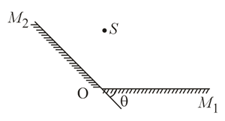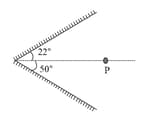Reflection of Light
Reflection of Light: Overview
This Topic covers sub-topics such as Reflection of Light, Plane Mirror, Laws of Reflection of Light, First Law of Reflection, Reflection from a Plane Mirror, Field of View, Regular and Diffused Reflection and, Second Law of Reflection
Important Questions on Reflection of Light
In the figure shown consider the first reflection at the plane mirror and second at the convex mirror. AB is object

A flat mirror is arranged parallel to the wall at a distance from it. The light produced by a point source kept on the wall is reflected by the mirror and produces a light spot on the wall. The mirror moves with velocity towards the wall.
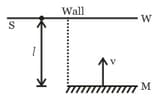
A point source of light is placed in front of two large mirrors as shown. Which of the following observers will see only one image of ?
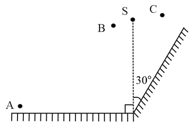
The reflection surface of a plane mirror is vertical. A particle is projected in a vertical plane which is also perpendicular to the mirror. The initial velocity of the particle is 10 m/s and the angle of projection is 60o. The point of projection is at a distance 5 m from the mirror. The particle moves towards the mirror. Just before the particle touches the mirror the velocity of approach of the particle and its image is:
There are two plane mirror with reflecting surfaces facing each other. The mirrors are moving with speed away from each other. A point object is placed between the mirrors. The velocity of the image will be
A light ray is incident on a plane mirror . The mirror is rotated in the direction as shown in the figure by an arrow at frequency . The light reflected by the mirror is received on the wall at a distance from the axis of rotation. When the angle of incidence becomes find the speed of the spot (a point) on the wall?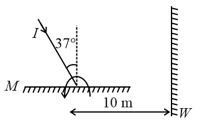
A point source of light placed at a distance in front of the centre of a mirror of width hung vertically on a wall. A man walks in front of the mirror along a line parallel to the mirror at a distance from it as shown in figure. The greatest distance over which he can see the image of the light source in the mirror is :
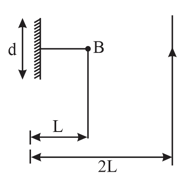
Two plane mirrors are at right angles to each other. A man stands between them and combs his hair with his right hand. In how many of the images will he seen using his right hand?
A small object is placed 30 cm in front of a plane mirror. If you stand behind the object 30cm from the object 30 cm from the object and look at its image, the distance focused for your eye will be at
A virtual and same size image as object can be obtained by-
An object is kept in front of two plane mirrors as shown in the figure. The number of images formed is . Find out the value of .
A monochromatic beam of light enters a square enclosure with mirrored interior surfaces at an angle of incidence (see the figure below). For some value(s) of , the beam is reflected by every mirrored wall (other than the one with opening) exactly once and exists the enclosure through the same hole. Which of the following statements about this beam is correct?
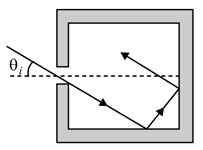
Two mirrors are inclined at an angle as shown in the figure. Light ray is incident parallel to one of the mirrors. Light will start retracing its path after third reflection if :
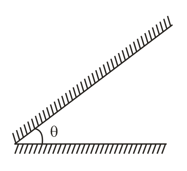
An object and a plane mirror are shown in figure. Mirror is moved with velocity as shown. The velocity of image is :
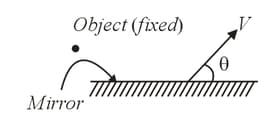
A ray of light is incident on a plane mirror at an angle of The angle of deviation produced by the mirror is
An object moves in front of a fixed plane mirror. The velocity of the image of the object is
A ray of light travelling in the direction is incident on a plane mirror. After reflection, it travels along the direction The angle of incidence is:
The image of an object due to reflection from the surface of a lake is elongated due to the ripples on the water surface caused by a light breeze. This is because the ripples act as tilted mirrors as shown below. Consider the case, where and the observer are at the same height above the surface of the lake. If the maximum angle that the ripples make with the horizontal is , then the angular extent of the image will be

An object is moving towards a concave mirror of focal length . When it is at a distance of from the mirror its speed is . The speed of its image at the instant is
In the arrangement shown in figure, is a point source, and are two plane fixed mirrors inclined at an angle with each other. If , then the value of distance between two images formed.
